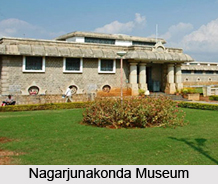 Nagarjunakonda is situated 150 km southeast of Hyderabad in the Indian state of Andhra Pradesh. According to the historical evidence, human activity began here as early as 20,000 years ago. Several remnants from prehistoric times including tools such as stone- axes were located and identified here in Nagarjunakonda.
Nagarjunakonda is situated 150 km southeast of Hyderabad in the Indian state of Andhra Pradesh. According to the historical evidence, human activity began here as early as 20,000 years ago. Several remnants from prehistoric times including tools such as stone- axes were located and identified here in Nagarjunakonda.
The agrarian communities of 3000 BC settled here along the banks of the Krishna River. Nagarjunakonda and nearby places Amaravati became the areas of powerful Hindu and Buddhist empires since the 2nd century BC until the early 3rd century AD. It was earlier known as Sriparvata and was surrounded by the Vijayapuri city. The present name is said to have derived from the name of one of the most well known Buddhist `Nagarjuna`. He governed the `Satigha` for nearly 60 years around the turn of the 2nd century AD. Nagarjuna established the Madhyamika School, which studied and developed the teachings of Mahayana Buddhism. Students from various countries like Sri Lanka and China came here to study here in this school. The philosophical concepts of this school still shape the basis of debate among Buddhist scholars.
By the 3rd century AD, the Hindu Ikshvakus settled in Nagarjunakonda region. These people erected a large amphitheatre and trading centre here. This was probably influenced by the Romans. They honoured the gods, Vishnu and Siva, with huge monuments. The Chalukyas and later the Pallavas ruled here in Nagarjunakonda. The culture and architecture of this region was influenced by these dynasties. There is a hill fort in Nagarjunakonda, which was thought to be built by the Vijayanagar Empire in the 14th century. The region got destructed from the 16th century.
A.R. Saraswathi, an archaeologist discovered the remains of the earlier civilizations in 1926. The Nagarjuna sagar, a huge reservoir was constructed to supply water in 1950 for irrigation and the generation of electricity. The Nagarjuna Sagar is situated at almost 1000km from the source of the Krishna River. The reservoir when full has a level for 180m and is 175 km wide.
Some of the excavations were undertaken here in Nagrjunakonda before the flooding in 1960. These excavations revealed the remains of stupas, viharas, chaityas and mandapams, as well as some outstanding examples of white marble carvings and sculptures depicting the life of the Buddha. Almost 100 important sites were identified.
Several ancient monuments and structures were eliminated and reconstructed within the walls of the nearby hilltop fort. It is now an island in the middle of the dam. The Nagarjunakonda Museum can also be found in the island. In this museum, one can see the Stone Age picks, hoes, axes, hammers and spears. Some of the coins and the coin moulds of local rulers, the Satavahanas and later Ikshvakus are also found in the museum here. There are also notable sculptures of large, voluptuous women standing side by side with exquisite Buddhas. The Jataka stories are also carved very nicely on long, slim slabs. The original positioning of the stupas, tanks, monastery and university can be imagined from the large model of the Nagarjunakonda Valley.



















